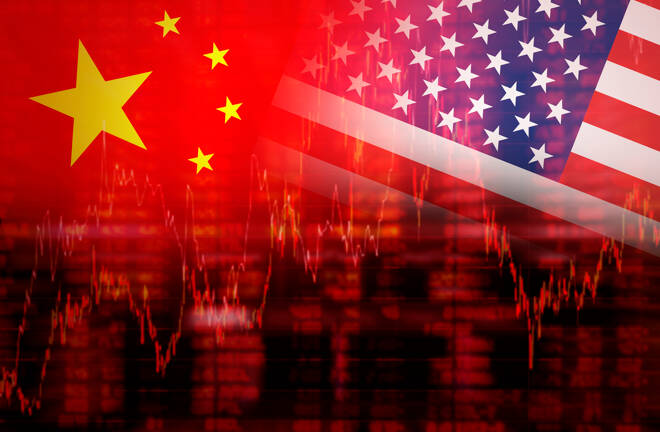Advertisement
Advertisement
US-China Trade Tensions Simmer as China’s Tech Sector Defies US Pressure
By:
Key Points:
- US weighs broader chip curbs; China warns of legal action over discriminatory measures.
- Morgan Stanley raises China’s 2025 GDP forecast to 4.5% as trade tensions ease.
- Hang Seng Tech Index climbs 18.8% YTD, outpacing US tech giants in global performance.
Chip War Escalates: Nvidia Hits Back as China’s Growth Outlook Shifts
The tech sector remains a key flashpoint in US-China trade tensions, with the Trump administration intensifying its focus on Chinese semiconductor firms. On Wednesday, May 21, Nvidia (NVDA) CEO Jensen Huang criticized the US chip export policy, arguing it had backfired. Huang noted that restrictions only led buyers to turn to Huawei, stating:
“All in all, the export control was a failure. The fundamental assumptions that led to the AI diffusion rule in the beginning, in the first place, has been proven to be fundamentally flawed.”
Huang’s remarks come as the spotlight on AI chips intensifies, with reports suggesting the US may expand its export blacklist to include additional Chinese semiconductor firms. China warned that entities complying with such measures may face legal consequences, calling the actions discriminatory.
Morgan Stanley Raises China’s Growth Forecasts
While tech-sector frictions persist, broader trade tensions have eased, supporting a more optimistic economic outlook. On May 21, CN Wire reported that Morgan Stanley (MS) revised its 2025 and 2026 GDP growth projections for China to 4.5% and 4.2%, respectively, up from 4.2% and 4.0%. The US banking giant revised its forecasts in response to lower tariffs and easing US-China trade tensions.
Still, the bank highlighted key risks, including housing market stress and soft household spending, despite Beijing’s stimulus efforts.
China’s Real Estate Slump Deepens
Housing conditions remain troublesome, undermining consumer confidence. The Kobeissi Letter reported:
“New home prices in China’s 70 major cities dropped 4.6% year-on-year in April. Existing home prices fell 6.8%, after a 7.3% drop in March. Chinese home prices have now declined for nearly four years STRAIGHT. Meanwhile, property investment declined 10.3% year-over-year in the first 4 months of 2025. All while new construction starts by property developers fell 23.8% during the same period. China’s real estate sector is in a worse recession than 2008.”
The slump has significantly impacted consumer sentiment, reinforcing a higher savings rate. A sustained recovery in the housing and labor markets remains crucial for China’s transition to a consumption-driven economy.
Recent economic indicators have underscored the challenges Beijing faces to boost consumption. April data showed persistent deflationary pressures, while slowing retail sales.
Notably, Morgan Stanley expects Beijing to roll out fewer stimulus measures as trade tensions ease. But weak consumption may still leave China vulnerable to global demand shocks.
East Asia Econ noted fading momentum, stating:
“China-Q4 pick-up is already fading. Headline YoY data are still benefiting from the Q4 pick-up, meaning another 5% growth quarter is likely. But subsequently, growth is slowing again, with no sign of any turnaround in construction that might put a sustainable floor under the overall economy.”
As of mid-Q2 2025, macroeconomic uncertainty continues to test investor sentiment.
US Markets Trail Hong Kong Tech Stocks
As economic risks linger, market performance has diverged sharply. The Hang Seng Index has gained 18% year-to-date (YTD), outpacing US markets as Hong Kong and Mainland China-listed tech stocks outperform. The Hang Seng Tech Index is up 18.8%, while the MAG 7 group is down 5.51%, dragging the Nasdaq Composite Index to a 2.27% YTD loss.
Meanwhile, Mainland China’s CSI 300 is down 0.35%, and the Shanghai Composite Index has gained 1.04%. Notably, China’s tech sector continues to lead, with the Roundhill China Dragons ETF soaring 27% YTD.
Outlook
Trade relations will remain a key driver of sentiment. A renewed flare-up in US-China tensions could prompt risk aversion, while targeted policy support from Beijing may buoy markets. Fed guidance on interest rates will also be critical as it responds to inflation risks tied to tariffs.
Follow our full coverage as US-China tech tensions reshape global markets.
About the Author
Bob Masonauthor
With over 28 years of experience in the financial industry, Bob has worked with various global rating agencies and multinational banks. Currently he is covering currencies, commodities, alternative asset classes and global equities, focusing mostly on European and Asian markets.
Advertisement
